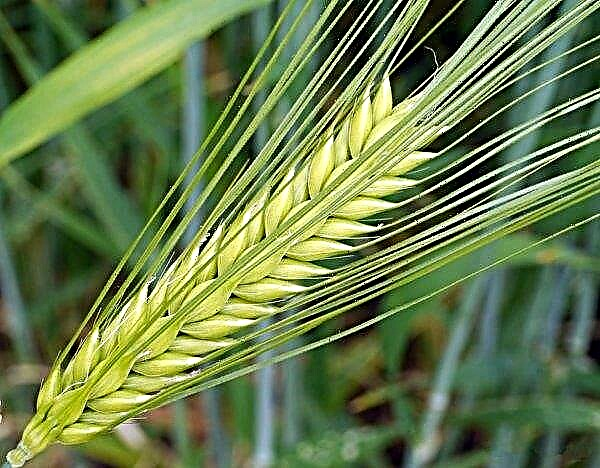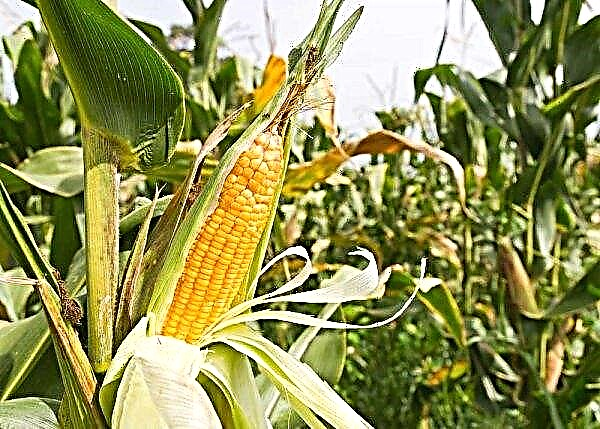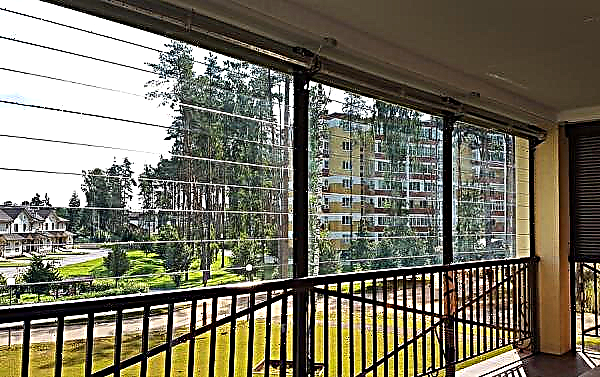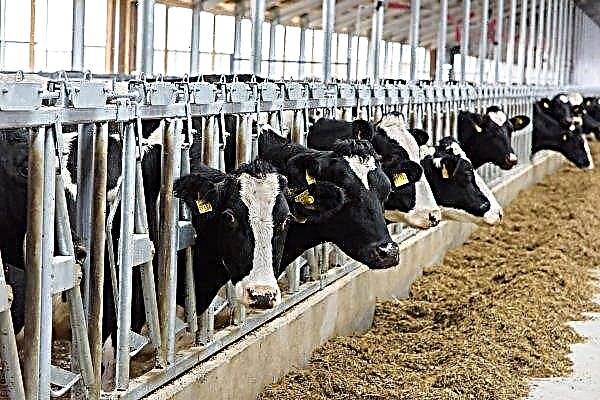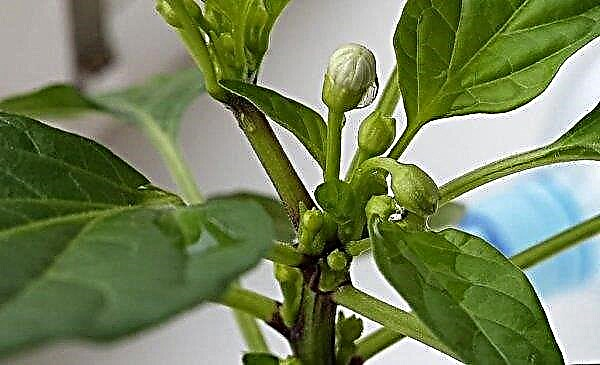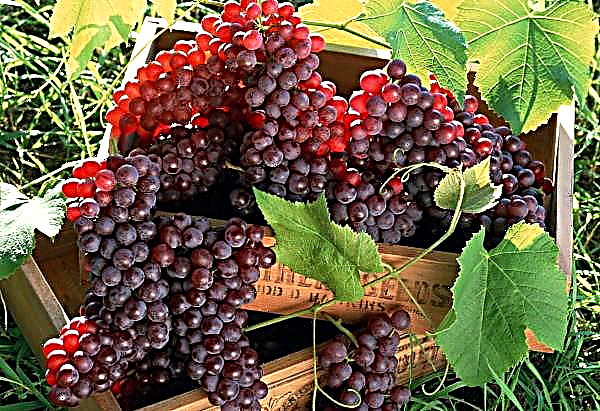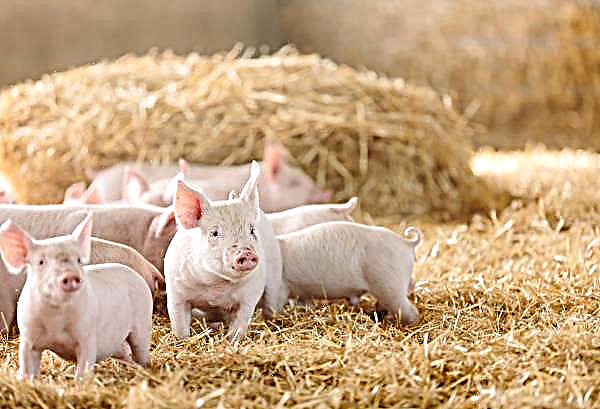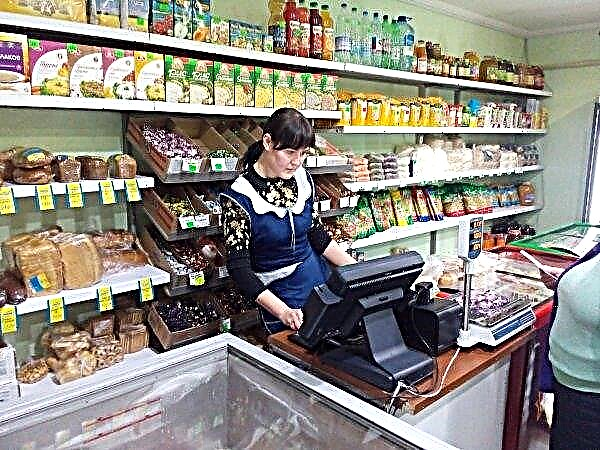Potatoes are grown in almost every farm. One of the best species, which is characterized by high productivity, good presentation and excellent taste of tubers, is the Romano variety. In this article, we consider its characteristics, especially planting, cultivation and care, as well as possible problems when growing varieties and methods for solving them.
Characteristic and Description
The Romano potato variety was bred in Holland in the 90s of the twentieth century. The originator of the variety is “AGRICO U.A.”. He entered the territory of Russia in 1994 and has been gaining popularity since then. It is grown for industrial purposes and in small private households.
Did you know? Potato berries are very toxic to humans. For serious poisoning, it is enough to eat only a couple of pieces.
The main characteristics of the Romano variety are presented below:
- Bushes have medium height and erect stems. On the garden, the plants look compact.
- The leaves are slightly wavy, painted dark green in color, have medium sizes. Potato tops look voluminous.
- Potato Romano blooms with red-violet inflorescences, which consist of large flowers.
- The variety is mid-early, the crop is harvested 65–80 days after emergence.
- Fruits are large or medium in size, have a beautiful round shape. The mass of one fruit is from 70 to 90 g.
- The peel of the tubers is smooth and dense, painted pink. On the surface of the tuber there are small eyes.
- The pulp has a light cream color and an excellent rich taste. Presentation of harvested mature tubers is about 96%.
- The fruits are perfectly stored in a cool cellar or basement at a temperature of +2 ... + 5 ° C, are not prone to germination.
- The Romano variety has good immunity to common diseases (cancer, leaf curling virus, tuber blight, tobacco mosaic). Plants are rarely attacked by a Colorado potato beetle, but are susceptible to a potato nematode.

Productivity
When grown under various climatic conditions and usual care, Romano potatoes yield an average of 110 to 340 kg / ha. In the southern regions and on fertile soils, this figure can reach 600 c / ha.
Large or medium-sized fruits predominate in the harvested crop, up to 9 may be in one nest. Small tubers are practically absent. Such indicators make the cultivation of this variety profitable and allow you not to worry about the harvest.
Important! If you provide the plants with good care, then from one bush you can collect up to 0.8 kg of large potatoes.
Taste qualities
Potato Romano belongs to the table varieties. Its flesh has a light milky hue and contains up to 17% starch. Thanks to this, when boiling, the tubers are well-digested and ideal for mashed potatoes. Romano potatoes are also used for frying, producing chips, stewing and baking.
Taste qualities of this grade are very high. On a 5-point scale for assessing taste, the Romano variety received a score of 5 points. Its pulp is dense, not watery, slightly darkens during cutting.
Growing regions
Variety Romano is sensitive to low air temperatures and frosts. Therefore, it is recommended to grow it in the middle lane or southern regions. The plant can tolerate hot summers and arid climates, subject to additional watering. Romano potatoes are successfully cultivated in all countries of Eastern Europe, the middle lane and the southern regions of Russia.
Advantages and disadvantages
Potato Romano attracts many farmers with its many virtues.
- The list of pluses of the variety include:
- high productivity;
- good tuber shelf life;
- great taste;
- attractive presentation;
- resistance to mechanical damage;
- high transportability;
- unpretentiousness to growing conditions;
- immunity to common diseases.
- The disadvantages of the Romano variety include:
- susceptibility to the golden nematode;
- the need to change the seed every 5 years;
- sensitivity to frost;
- thick peel, which complicates the culinary processing of fruits and necessitates the preliminary germination of seed tubers.
Planting and growing potatoes
Romano potatoes are not picky about growing conditions, but some minimal recommendations for choosing a place for plants need to be followed.
Did you know? Potatoes were brought into Europe around 1580, but for a long time was considered unfit for food.
This will help to get the maximum yield from the bushes and prevent problems. A plot for growing tubers of the Romano variety must meet the following requirements:
A plot for growing tubers of the Romano variety must meet the following requirements:
- to be well lit - in the shade, the plants will grow much worse and the tubers in the nest will be small;
- have loose and nutritious soil - in heavy soil, planting material sprouts worse, and the lack of fertilizers affects the quality and volume of the crop;
- not contain ground water lying close to the surface of the earth - bushes react poorly to waterlogged soil. If potatoes are planted on a site with a high occurrence of groundwater, then planting should be carried out on the ridges;
- to reduce the risk of disease, it is not recommended to plant Romano potatoes in areas where previously grown tomatoes, peppers or eggplant;
- a good harvest of tubers can be obtained if plant the Romano variety in the area where cereals or legumes, cabbage, greens, beets or carrots were grown before.
Selection of planting material
In order for Romano potatoes to give a good harvest, you need to start growing it with the correct fruit planting. Proper preparation of seed tubers helps to get the first green shoots within 8-12 days after planting.
Consider the basic rules for choosing and preparing potatoes for planting:
- tubers should be free of deformation, damage and rot;
- the weight of one fetus should be about 80 g;
- 20 days before the planned planting, seed tubers are laid out in a warm (+14 ... + 16 ° С) and well-lit place for germination;
- so that the seed potatoes do not dry out in a warm room, it is periodically sprayed with warm water;
- for better germination, seed tubers are treated with a solution of mineral fertilizers or a growth stimulator;
- to increase the immunity of plants to diseases and pests, tubers are treated with fungicides before planting;
- if the potato is too large, then before planting the fruits are cut into pieces so that each of them has 2-3 eyes.
 Experienced gardeners recommend changing the seed of Romano potatoes at least every 5 years. During this period, the variety begins to degenerate, and this leads to a decrease in yield and fruit size.
Experienced gardeners recommend changing the seed of Romano potatoes at least every 5 years. During this period, the variety begins to degenerate, and this leads to a decrease in yield and fruit size.Important! Tuber planting is carried out after the appearance of sprouts on them up to 5 cm long.
Soil preparation
The highest yields are achieved when growing this variety in fertile and loose soil.
Other types of soil before planting potatoes need a little preparation:
- lime or ash is added to acidic soil;
- dense clay soil is diluted with humus or peat (1 bucket is enough for 1 m²);
- sandy soil is fertilized with humus and diluted with clay soil;
- compost or manure, clay and coarse sand are added to peat soil.
In autumn, it is recommended to deep dig the site. This will help prevent the occurrence of diseases and improve the breathability of the soil. Before planting in the spring, the soil is again dug up to a depth of 20 cm and loosened with a harrow.
Potato planting
The timing of planting Romano potatoes in open ground largely depends on the climatic conditions of a particular region. For the southern regions, landing is possible in mid-April, provided that no night frost is expected. In other regions, potatoes are planted in late May or early June. By the time of planting, the air temperature should be at least + 15 ° C, and the soil on the site should be well heated. In the cold earth, tubers quickly begin to rot and do not germinate. Tubers should not be planted in too moist and very dry soil.
By the time of planting, the air temperature should be at least + 15 ° C, and the soil on the site should be well heated. In the cold earth, tubers quickly begin to rot and do not germinate. Tubers should not be planted in too moist and very dry soil.
Did you know? Under the influence of direct sunlight, solanine, a substance poisonous to the human body, accumulates in the potato tubers.
The process of planting Romano potatoes is described below:
- Dig holes in the soil 10–20 cm deep, placing them in rows at a distance of 60–80 cm from each other. The lighter the soil on the site, the greater the depth of the hole. Between the rows you need to leave a distance of about 50 cm.
- If the land on the site is too dry, then the holes can be slightly watered.
- Add humus, a handful of ash or mineral fertilizers to each well.
- Place seed potatoes in the hole with their sprouts up. If small fruits weighing about 20 g are used for planting, then 2-3 tubers should be placed in one hole.
- Sprinkle the recess with earth, level the surface a little.
If Romano potatoes are planted in sandy soil, and the growing region is characterized by a hot dry climate, it is recommended to place tubers in trenches up to 10 cm deep.
Features of care for the Romano variety
This potato variety does not require specific care. To achieve good yield indicators, it is enough to carry out standard actions that contribute to the normal growth and development of the plant. The main stages of care for Romano bushes include:
The main stages of care for Romano bushes include:
- Timely watering - carried out when grown in a hot climate during the active growth of green tops by potatoes and during flowering. Usually the bushes are watered about 3 times per season.
- Root dressingpromoting good plant growth. It is carried out after watering and is carried out three times per season: after the first shoots appear, during flowering and 10-14 days after it, when tubers begin to form. As a fertilizer, you can use an aqueous solution of mullein, bird droppings, urea or mineral fertilizers.
- Foliar top dressing carried out during the period of active growth of green tops until the flowering bushes. Plants are sprayed with superphosphates, a solution with urea or nettle infusion.
- Weeding beds with potatoes - carried out after irrigation or rain so that moisture and nutrients from the soil are not absorbed by weeds. This procedure is recommended at least 2-3 times per season.
- Soil cultivation - It is also carried out periodically after rain and watering. This procedure helps eliminate dense soil crust on the soil, improves air exchange with the roots and keeps the soil moist for a long time.
- Hilling bushes - allows you to form a compact nest of tubers and keeps the soil moist and loose for longer. The first time the hilling process is carried out when the height of the bushes exceeds 10 cm, and again after the plants reach a height of 15–20 cm.
- Mulching beds - carried out to control weeds, retains moisture in the soil longer.
- Preventive treatment of bushes copper-containing drugs that prevent the appearance of pests and diseases.
Important! With a lack of nutrients in the soil, Romano potato yield decreases, and excessive watering can lead to plant diseases.
Pests and diseases of the variety
Plants and tubers of this variety are slightly susceptible to potato cancer, viral infections, late blight of fruits and tobacco mosaic. But sometimes the bushes can be affected by other diseases. In order to notice the problem in time and save the crop, you need to know the main symptoms of infection and properly carry out the treatment. A list of the main diseases and pests affecting Romano potatoes is presented below:
A list of the main diseases and pests affecting Romano potatoes is presented below:
- Common scab. The disease belongs to the fungal and affects the tubers, as a result of which they are covered with rough dark growths. Gradually, the fruits are covered with a rough crust and rot during storage. The source of infection can be infected fruits used for planting, as well as last year's plant debris in the soil in which the fungus develops. It is impossible to cure this disease, but its spread can be prevented using the preventive measures described later in the article.
- Late blight. Occurs in a cool climate and high soil moisture. A characteristic white coating appears on the lower surface of the sheet, and brown spots appear on the upper part. Subsequently, the entire green part of the bush dries up, and the infection can pass to potato tubers. To treat the disease, the bushes are sprayed with a 1% solution of Bordeaux liquid or 0.5% solution of copper chloroxide. Processing is carried out every week, to eliminate the disease 3-4 spraying is required. If a significant part of potatoes is infected with late blight, then chemical preparations - arcerides are used for treatment.
- Golden nematode. The pest is a worm that lives in the ground and eats potato tubers. When a parasite appears on a potato bed, some bushes begin to slow down, become sluggish and weak, and the tubers are small or not growing at all. If you dig a diseased bush from the ground and examine its roots, you will notice tiny white or golden worms. Nematode larvae remain viable for 10 years and are transported with soil particles, infected fruits, or through agricultural implements. Sick plants are treated with chemical agents from pests.



Universal measures for the prevention of these diseases include:
- use for planting only healthy tubers;
- treatment of tubers with fungicides before planting;
- regular inspection of plants;
- proper watering of potatoes;
- growing potatoes on a site that was used last year to plant lupine, crops;
- treatment of bushes with preparations containing copper;
- change of potato growing area every 2-3 years.
Harvesting and storage
The first digging of young fruits can be done already in early July. The main part of the crop is harvested in early September. 7-8 days before the planned harvest, the potato tops are mowed. This procedure helps strengthen the skin of the tubers and makes their flesh denser.
Important! Due to the stable immunity and thick peel, the tubers of the Romano variety tolerate long-term winter storage.
After harvesting the tubers perform the following actions:
- the fruits are dried in the open air under a canopy for 3-5 days;
- reject damaged and spoiled fruits;
- seed material is selected for planting for the next year;
- send potatoes for storage in a dark room with an air temperature of +2 ... + 5 ° С.
 Romano potatoes can be successfully grown in many regions due to their unpretentiousness to climate conditions. If you follow the recommendations listed in the article for caring for a plant, you can get a plentiful harvest from beautiful and large tubers that have excellent taste and good presentation.
Romano potatoes can be successfully grown in many regions due to their unpretentiousness to climate conditions. If you follow the recommendations listed in the article for caring for a plant, you can get a plentiful harvest from beautiful and large tubers that have excellent taste and good presentation.


